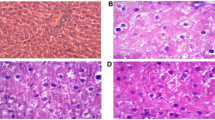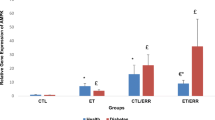Abstract
Liver X receptor α (LXRα) is a member of the ligand-activated transcription factor of nuclear hormonal receptor superfamily, whose activation leads to modulation in the expression of genes involved in cholesterol homeostasis including ATP-binding cassette transporter A1 (ABCA1), which plays a crucial role in plasma high-density lipoprotein cholesterol (HDL-C) remodeling. The purpose of this study was to investigate whether endurance training enhanced the expression level of liver LXRα gene. Twelve adult male Wistar rats (200–220 g) were divided into control and training groups. Training group received exercise on a motor-driven treadmill at 28 m/min (0 % grade) for 60 min/day, 5 days/week for 8 weeks. Twenty-four hours after the last exercise session, the rats were killed and blood was taken from the right ventricle of each rat. Plasma was collected for HDL-C, low-density lipoprotein cholesterol (LDL-C), TC and TG measurements. Furthermore, a portion of the liver of each rat was excised and washed in ice-cold saline and frozen in liquid nitrogen for assessment of LXRα and ABCA1 mRNA levels. Data indicated significant increase in both LXRα and ABCA1 mRNA levels in trained rats, compared to control rats. Plasma HDL-C concentration was significantly higher (P < 0.001) in trained rats at the end of treadmill exercise. However, there was a significant decrease in LDL-C (P < 0.003), TG, TC concentration, TC/HDL-C and LDL/HDL-C ratios in trained rats compared with those in the control group (P < 0.001). In conclusion, we found that endurance training induced significant elevation in LXRα gene expression, which correlated with enhanced levels of ABCA1 mRNA and plasma HDL-C concentration.


Similar content being viewed by others
Abbreviations
- ABCA1:
-
ATP-binding cassette transporter A1
- CAD:
-
Coronary artery disease
- HDL-C:
-
High-density lipoprotein cholesterol
- LDL-C:
-
Low-density lipoprotein cholesterol
- LXR:
-
Liver X receptor
- RCT:
-
Reverse cholesterol transport
- TC:
-
Total cholesterol
- TG:
-
Triglycerides
References
Apfel R, Benbrook D, Lernhardt E, Ortiz MA, Salbert G, Pfahl M (1994) A novel orphan receptor specific for a subset of thyroid hormone-responsive elements and its interaction with the retinoid/thyroid hormone receptor subfamily. Mol Cell Biol 14:7025–7035
Baranowski M (2008) Biological role of liver X receptors. J Physiol Pharmacol 59:31–55
Baranowski M, Zabielski P, Błachnio-Zabielska AU, Harasiuk D, Go′rski J (2011) LXR activation prevents exhaustive exercise-induced hypoglycaemia and spares muscle glycogen but does not enhance running endurance in untrained rats. Acta Physiol 201:373–379
Beltowski J, Semczuk A (2010) Liver X receptor (LXR) and the reproductive system—a potential novel target for therapeutic intervention. Pharmacol Rep 62:15–27
Brunham LR, Kruit JK, Pape TD, Parks JS, Kuipers F, Hayden MR (2006) Tissue-specific induction of intestinal ABCA1 expression with a liver X receptor agonist raises plasma HDL cholesterol levels. Circ Res 99(7):672–674
Butcher LR, Thomas A, Backx K, Roberts A, Webb R, Morris K (2008) Low-intensity exercise exerts beneficial effects on plasma lipids via PPARgamma. Med Sci Sports Exerc 40:1263–1270
Cooney MT, Dudina A, De Bacquer D, Wilhelmsen L, Sans S, Menotti A, De Backer G, Jousilahti P, Keil U, Thomsen T, Whincup P, Graham IM (2009) HDL cholesterol protects against cardiovascular disease in both genders, at all ages and at all levels of risk. Atherosclerosis 206(2):611–616
Cote I, Ngo Sock ET, Lévy E, Lavoie JM (2013) An atherogenic diet decreases liver FXR gene expression and causes severe hepatic steatosis and hepatic cholesterol accumulation: effect of endurance training. Eur J Nutr (in press) (Epub ahead of print). doi:10.1007/s00394-012-0459-5
Dabidi RV (2011) Effect of training on high sensitive C-reactive protein and blood lipids responses in rats. Middle East J Sci Res 1:115–122
Demacker PN, Hijmans AG, Brenninkmeijer BJ, Jansen AP, van ‘t Laar A (1984) Five methods for determining low density lipoprotein cholesterol compared. Clin Chem 30(11):1797–1800
Fukumoto H, Deng A, Irizarry MC, Fitzgerald ML, Rebeck GW (2002) Induction of the cholesterol transporter ABCA1 in central nervous system cells by liver X receptor agonists increases secreted Abeta levels. J Biol Chem 277(50):48508–48513
Ghanbari-Niaki A, Khabazian B, Hissainin-Kakhak A, Rahbarizadeh F, Hedayat M (2007) Treadmill exercise enhances ABCA1 in rat liver. Biochem Biophys Res Commun 361:841–846
Gupta AK, Ross EA, Myers JN, Kashyap ML (1993) Increased reverse cholesterol transport in athletes. Metabolism 42(6):684–690
Hong C, Bradley MN, Rong X, Wang X, Wagner A, Grijalva V, Castellani LW, Salazar J, Realegeno S, Boyadjian R, Fogelman AM, Van Lenten BJ, Reddy ST, Lusis AJ, Tangirala RK, Tontonoz P (2012) LXRα is uniquely required for maximal reverse cholesterol transport and atheroprotection in ApoE-deficient mice. J Lipid Res 53(6):1126–1133
Karanth J, Jeevaratnam K (2009) Effect of dietary lipid, carnitine and exercise on lipid profile in rat blood, liver and muscle. Indian J Exp Biol 47:748–753
Khabazian BM, Ghanbari-Niaki A, Rahbarizadeh F, Hosseini Kakhak SA, Jabari Kouchabi M (2008) The effect of 6 weeks endurance training of hepatic ABCA1 in male Wistar rats. Sport Sci 6:101–114
Leaf DA (2003) The effect of physical exercise on reverse cholesterol transport. Metabolism 52(8):950–957
Lehmann JM, Kliewer SA, Moore LB (1997) Activation of the nuclear receptor LXR by oxysterols defines a new hormone response pathway. J Biol Chem 272:3137–3140
Lespessailles E, Jaffre C, Rochefort GY, Dolle E, Benhamou CL, Courteix D (2010) Exercise and zoledronic acid on lipid profile and bone remodeling in ovariectomized rats: a paradoxical negative association? Lipids 45:337–344
Nagasawa SY, Okamura T, Iso H, Tamakoshi A, Yamada M, Watanabe M, Murakami Y, Miura K, Ueshima H (2012) Relation between serum total cholesterol level and cardiovascular disease stratified by sex and age group: a pooled analysis of 65,594 individuals from 10 cohort studies in Japan. J Am Heart Assoc 1(5):e001974
Olchawa B, Kingwell BA, Hoang A, Schneider L, Miyazaki O, Nestel P, Sviridov D (2004) Physical fitness and reverse cholesterol transport. Arterioscler Thromb Vasc Biol 24:1087–1091
Parakh AC, Gank DH (1982) Free and total cholesterol. In: Bauer JD (ed) Clinical laboratory methods. Mosssby Company, Toronto, pp 546–549
Petridou A, Nikolaidis MG, Matsakas A, Schulz TH, Michna H, Mougios V (2005) Effect of exercise training on the fatty acid composition of lipid classes in rat liver, skeletal muscle, and adipose tissue. Eur J Appl Physiol 94:84–92
Powers SK, Criswell D, Lawler J, Martin D, Lieu FK, Ji LL, Herb RA (1993) Rigorous exercise training increases superoxide dismutase activity in ventricular myocardium. Am J Physiol 265:2094–2098
Roth SM, Rankinen T, Hagberg JM, Loos RJ, Pérusse L, Sarzynski MA, Wolfarth B, Bouchard C (2012) Advances in exercise, fitness, and performance genomics in 2011. Med Sci Sports Exerc 44(5):809–817
Sato M, Kawata Y, Erami K, Ikeda I, Imaizumi K (2008) LXR agonist increases the lymph HDL transport in rats by promoting reciprocally intestinal ABCA1 and apo A-I mRNA levels. Lipids 43:5–131
Tang SL, Chen WJ, Yin K, Zhao GJ, Mo ZC, Lv YC, Ouyang XP, Yu XH, Kuang HJ, Jiang ZS, Fu YC, Tang CK (2012) PAPP-A negatively regulates ABCA1, ABCG1 and SR-B1 expression by inhibiting LXRα through the IGF-I-mediated signaling pathway. Atherosclerosis 222(2):344–354
Vincent HK, Powers SK, Stewart DJ, Demirel HA, Shanely RA, Naito H (2000) Short term exercise training improves diaphragm antioxidant capacity and endurance. Eur J Appl Physiol Occup Physiol 81:67–74
Warnick GR, Benderson J, Albers J (1982) Dextran sulfate-Mg2+ precipitation procedure for quantitation of high density lipoprotein cholesterol. Clin Chem 28:1378–1388
Wójcicka G, Jamroz-Wiśniewska A, Horoszewicz K, Bełtowski J (2007) Liver X receptors (LXRs). Part I: structure, function, regulation of activity, and role in lipid metabolism. Postepy Hig Med Dosw 61:736–759
Wouters K, Shiri-Sverdlov R, van Gorp PJ, van Bilsen M, Hofker MH (2005) Understanding hyperlipidemia and atherosclerosis: lessons from genetically modified apoE and ldlr mice. Clin Chem Lab Med 43:470–479
Zhao C, Dahlman-Wright K (2010) Liver X receptor in cholesterol metabolism. J Endocrinol 204:233–240
Zhao SP, Yu BL, Xie XZ, Dong SZ, Dong J (2008) Dual effects of oxidized low-density lipoprotein on LXR–ABCA1–apoA-I pathway in 3T3-L1 cells. Int J Cardiol 8:42–47
Zhao J, Tian Y, Xu J, Liu D, Wang X, Zhao B (2011) Endurance exercise is a leptin signaling mimetic in hypothalamus of Wistar rats. Lipids Health Dis 10:225–231
Zhou X, Yin Z, Guo X, Hajjar DP, Han J (2010) Inhibition of ERK1/2 and activation of liver X receptor synergistically induce macrophage ABCA1 expression and cholesterol efflux. J Biol Chem 285(9):6316–6326
Acknowledgments
This study was funded by a grant in aid of research from the Chancellorship Office for Research and Technology of the University of Isfahan (Grant No. 90/97891) awarded to Jamal Moshtaghian, Ph.D., which was used to support Fatemeh Kazeminasab for obtaining her M.Sc. degree from the University of Isfahan.
Conflict of interest
None of the authors has any conflicts of interest to disclose and all authors support submission to this journal.
Author information
Authors and Affiliations
Corresponding author
Additional information
Communicated by Martin Flueck.
Rights and permissions
About this article
Cite this article
Kazeminasab, F., Marandi, M., Ghaedi, K. et al. Endurance training enhances LXRα gene expression in Wistar male rats. Eur J Appl Physiol 113, 2285–2290 (2013). https://doi.org/10.1007/s00421-013-2658-z
Received:
Accepted:
Published:
Issue Date:
DOI: https://doi.org/10.1007/s00421-013-2658-z




